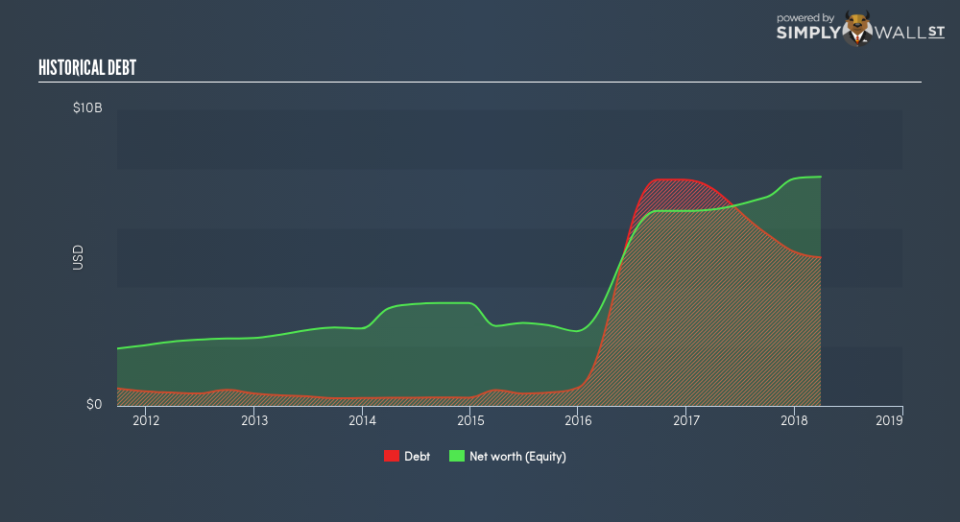What does Keurig Dr Pepper Inc’s (NYSE:KDP) Balance Sheet Tell Us About Its Future?

Investors seeking to preserve capital in a volatile environment might consider large-cap stocks such as Keurig Dr Pepper Inc (NYSE:KDP) a safer option. Doing business globally, large caps tend to have diversified revenue streams and attractive capital returns, making them desirable investments for risk-averse portfolios. However, the health of the financials determines whether the company continues to succeed. This article will examine Keurig Dr Pepper’s financial liquidity and debt levels to get an idea of whether the company can deal with cyclical downturns and maintain funds to accommodate strategic spending for future growth. Note that this commentary is very high-level and solely focused on financial health, so I suggest you dig deeper yourself into KDP here.
View our latest analysis for Keurig Dr Pepper
How much cash does KDP generate through its operations?
KDP’s debt levels have fallen from US$7.63b to US$5.00b over the last 12 months , which comprises of short- and long-term debt. With this debt payback, KDP currently has US$120.2m remaining in cash and short-term investments for investing into the business. Additionally, KDP has generated cash from operations of US$1.54b during the same period of time, resulting in an operating cash to total debt ratio of 30.7%, signalling that KDP’s current level of operating cash is high enough to cover debt. This ratio can also be a sign of operational efficiency as an alternative to return on assets. In KDP’s case, it is able to generate 0.31x cash from its debt capital.
Can KDP pay its short-term liabilities?
At the current liabilities level of US$2.04b liabilities, it appears that the company has not maintained a sufficient level of current assets to meet its obligations, with the current ratio last standing at 0.49x, which is below the prudent industry ratio of 3x.
Can KDP service its debt comfortably?
KDP is a relatively highly levered company with a debt-to-equity of 64.8%. This isn’t surprising for large-caps, as equity can often be more expensive to issue than debt, plus interest payments are tax deductible. Since large-caps are seen as safer than their smaller constituents, they tend to enjoy lower cost of capital. We can test if KDP’s debt levels are sustainable by measuring interest payments against earnings of a company. A company generating earnings before interest and tax (EBIT) at least three times its net interest payments is considered financially sound. In KDP’s case, the ratio of 3.86x suggests that interest is appropriately covered. Strong interest coverage is seen as a responsible and safe practice, which highlights why most investors believe large-caps such as KDP is a safe investment.
Next Steps:
KDP’s high cash coverage means that, although its debt levels are high, the company is able to utilise its borrowings efficiently in order to generate cash flow. Though its lack of liquidity raises questions over current asset management practices for the large-cap. Keep in mind I haven’t considered other factors such as how KDP has been performing in the past. You should continue to research Keurig Dr Pepper to get a more holistic view of the stock by looking at:
Future Outlook: What are well-informed industry analysts predicting for KDP’s future growth? Take a look at our free research report of analyst consensus for KDP’s outlook.
Valuation: What is KDP worth today? Is the stock undervalued, even when its growth outlook is factored into its intrinsic value? The intrinsic value infographic in our free research report helps visualize whether KDP is currently mispriced by the market.
Other High-Performing Stocks: Are there other stocks that provide better prospects with proven track records? Explore our free list of these great stocks here.
To help readers see past the short term volatility of the financial market, we aim to bring you a long-term focused research analysis purely driven by fundamental data. Note that our analysis does not factor in the latest price-sensitive company announcements.
The author is an independent contributor and at the time of publication had no position in the stocks mentioned. For errors that warrant correction please contact the editor at editorial-team@simplywallst.com.

